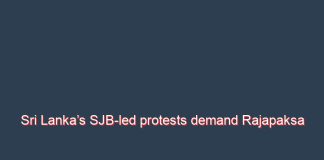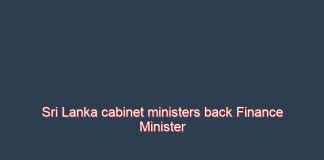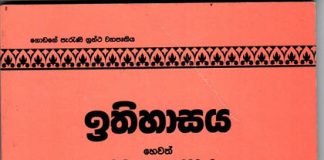Sri Lanka’s SJB-led protests demand Rajapaksa to step down amid economic...
ECONOMYNEXT – Thousands of protesters led by Sri Lanka’s main opposition Samagi Jana Balawegaya (SJB) staged protests demanding the president to resign due to his continuous failure in governance and economic policies.
The protesters gathered near the opposition’ office and marched for nearly 2 km towards President Gotabaya Rajapaksa’s office which is in front China’s Port City in the commercial heart pf Colombo asking
They carried placards which carried “GotaGoHome” asking the President (Gota) to go home.
The same words were written in a black head band which was worn by many protectors. Some held large light green and yellow collar banners with the words “Country is destroyed.. now enough”.
The opposition protesters criticized President Rajapaksa for the government’s messed up policies – from fertilizer to economic policies –
His decision to ban chemical fertilizer has hit the crop harvest in the last cultivation season while severe dollar shortage has led to extended power cuts due to lack diesel imports.
Protesters kicked a man who was wearing Finance Minister Basil Rajah’s face in a mask and smashed him with a sweeper while they brought a stretcher with a person lying with a slogan “people are dying because there is no medicine”.
Protesters carried coffins and burnt near the president’s office in front of the security personnel.
“If you can’t rule the country, give it to somebody else,” Opposition Leader Sajith Premadasa told the gathering before concluding the protest.
“We want a presidential election.”
Premadasa said Middle Eastern countries have agreed to grant fuel without any payment for two years when he establishes a government.
Failed Policies
President Rajapaksa’s Sri Lanka Podujana Peremiuna (SLPP)-led government has messed up with some key policy measures, opposition party says.
It’s fertilizer policy has reduced harvests sharply in the last cultivation season and the island nation is likely to face a food shortage because of that, the opposition has said.
Severe US dollar shortage has reduced the imports of fuel, cooking gas, and milk powder and an extended power cuts across the island nation.
People have been in queues for hours to buy cooking gas, fuel, milk power, wheat flour, and kerosene due to lack of dollars to import those commodities.
“Are you ready to send this government home as they have not listened to the people?” Sajith Premadasa asked when he addressed the protesters.
“All these people have come without fearing of possible tear gas spray,” he said.
After holding the rupee at 200 per US dollar for nearly one year, the central bank’s decision to allow flexibility in exchange rate has led to a nearly 40 percent depreciation since March 8.
The Sharp fall in the rupee also has made fuel, imports, essential foods, medicines, and transport services more expensive.
The government, after dragging for many months, finally, has decided to seek International Monetary Fund (IMF) assistance on Tuesday.
The SLPP government has been against an IMF programme and had refused to seek the global lender’s assistance when they realized the country was heading for an economic and debt crisis.
In fighting between SLPP ministers have led the public to suffer in the power sector while the country is facing heightened risk of sovereign debt default due to sharp drop in foreign reserves, an economic analyst said.
Analysts say Tuesday’s protest was a tip of an ice berg of the frustrated public in the country.
The latest protest comes after the government’s strong coalition has showed clear signs of split.
The government has already lost two-third majority in the parliament after President Rajapaksa sacking two key cabinet ministers early this month.
Political analysts say the split has strengthened the opposition.
Tuesday’s protests saw tensed situation between security forces and the protesters.
The protesters were allowed to come near the presidential office next to the island nation’s protesting site and Chinese-owned high end Sangri-La hotel.
Police officials facilitated the protesters to come neat the protesting site by closing some roads in the commercial heart of Colombo. (Colombo/March15/2022)
Sri Lanka shares fall for third straight session; mkt shrugs off...
ECONOMYNEXT – Sri Lanka stock index dropped for a third straight session on Tuesday (14) to a near one-week low as economic uncertainties after the currency depreciation weighed on the sentiment, brokers said.
Investors shrugged off a government decision that the cabinet had given approval for the Finance Minister to seek International Monetary Fund assistance to address the current economic crisis.
The main All Share Price Index (ASPI) fell 2.66 percent or 280.96 points to close at 10,284.30, its lowest since March 9. It has been on the fall since posted a record high daily percentage gain on Thursday (10).
The market turnover was 1.67 billion rupees, less than a third of this year’s average daily turnover of 5.7 billion rupees.
The fall also came as the government’s treasury bill yield rose on Tuesday to above 11 percent.
Analysts have said the gain seen on Thursday was unsustainable as only a few select shares moved the market.
Analysts predict some investors to move into fixed assets with the return on risk free government bonds expected to move above 13 percent and while 5-year maturities expected to rise above 15-percent.
In the late afternoon trade on Tuesday rupee was quoted at 275/285 to the US dollar. The rupee had fallen around 40 percent so far since the central bank allowed greater flexibility on March 8.
All commodity prices in Sri Lanka are on the rise due to the currency fall. Currency dealers expect more depreciation in the coming days.
S&P SL20 of the most liquid stocks fell 2.82 percent or 101.95 points to 3,514.83 points.
Rising oil price, policy rate hike, a slowing economy, and shortage of dollars, fuel, and cooking gas along with extended power cuts also weighed on the sentiment.
Sri Lanka’s central bank early this month raised the key monetary policy interest rates by 100 basis points to more than a two-year high in a bid to reduce pressure on the currency that was created by excess money printing while keeping the interest rates at a low level to spur pandemic-hit economic growth.
The market has already lost 11.1 percent so far in March after falling 11 percent in the previous month. Overall the market has lost 15.9 percent so far this year after being one of the world’s best stock markets with an 80 percent return last year.
Foreign investors bought a net 95.4 million rupees worth of shares. So far this year, the market has witnessed a total foreign outflow of 2.6 billion rupees.
Market heavyweight Expolanka, LOLC, and Browns Investments Plc dragged the main index down on Tuesday.
Shares in Expolanka fell 6.2 percent to close at 256.25 rupees a share, while LOLC dropped 4.9 percent to 791.50 .
Browns Investments Plc 4.6 percent down at 10.50 rupees a share. (Colombo/March15/2022)
Sri Lanka cabinet ministers back Finance Minister to seek IMF support
ECONOMYNEXT – Sri Lanka’s cabinet of ministers had given Finance Minister Basil Rajapaksa the go ahead to seek International Monetary Fund, a government minister said as the soft-pegged rupee suffers the worst currency crisis in its history.
“Finance Minister told us (at the cabinet meeting) that we will have go to the IMF. What do you say?” Minister Chandrasena told Sri Lanka’s Derana Television in a late night talk show.
“We all said to go. I also said to go. Nobody opposed.”
Sri Lanka has a Latin America style soft-peg set up by a US money doctor in 1950 which depreciates every time domestic credit picks up and economists using Keynesian dogma try to control interest rates by printing money.
The rupee fell from 203 to around 265 to the US dollar over the past week after the central bank started a float (suspension of convertibility) of the currency to end sterilized interventions.
Analysts have said a surrender rule requiring commercial banks to sell dollars to the central bank for new money, undermines the float and further weakens the currency.
Sri Lanka’s Keynesian economists who favour state spending, fiercely oppose market driven interest rates and push the country into currency depreciation after building large domestic credit imbalances with artificially low interests enforced by money printing (central bank credit).
Many cabinet ministers have publicly supported going for an IMF program, while anti-austerity economists have ideologically opposed the move.
The IMF primarily stabilizes a country by raising rates to reduce domestic credit and also raising taxes to cut the deficit, which also helps moderate interest rates.
Keeping an exchange rate fixed or stable by allowing the short term rates to float is the most simple monetary regime in the world. It was the basic building block of economic stability in most East Asian nations.
The Minister’s comments came as IMF’s Asia Pacific Director Changyong Rhee is visiting Sri Lanka to brief President Gotabaya Rajapaksa about the Washington based lenders’ staff report, the Executive Board’s comments.
The IMF has warned that Sri Lanka’s economy could implode unless money printing was halted.
Sri Lanka president to address the nation on Wednesday amid economic...
ECONOMYNEXT – Sri Lanka President Gotabaya Rajapaksa will address the nation on Wednesday (16), his media unit said, as the island nation has been witnessing sharp rise in prices in all essential goods and services following the rupee fall amid public protests.
The content of the speech is expected to be the prevailing situation in the country.
Since the central bank allowed flexibility in the exchange rate on March 8, the rupee has fallen nearly 32 percent so far.
With the rupee fall, prices of fuel, wheat flour, transport, rice parcel, container transport, air tickets, and many other essential goods have been raised and people have started grumbling about the latest cost of living.
The president’s speech also comes as opposition parties have called people to join them for protests against the government’s economic mismanagement and policy failures.
The opposition protests blame Rajapaksa’s Sri Lanka Podujana Party (SLPP)-led government for a messed up fertilizer policy and mismanagement of economic policies.
The main opposition Samagi Jana Balawegaya has planned a protest in Colombo on Tuesday.
The country has seen shortage of fuel, cooking gas, milk powder, sugar, and wheat flour in the recent past mainly due to severe shortage of US dollars as the island nation’s reserves dwindled over 70 percent in the first 11 month of 2021.
The fuel shortage has resulted in extended power cuts across the country. (Colombo/March14/2022)
Colombo takes to the Streets
ඉතිහාසය හෙවත් ලක්දිව්වාසී ජනයා පිළිබඳ වූ පුරාණ කාලයෙහි කතාදිය
German travel vlogger in Sri Lanka mulls leaving as money printing...
ECONOMYNEXT – A German vlogger, going by the name of Ken Abroad that captured the hearts thousands of youtube users in Sri Lanka has said he may cut his visit short and leave the country as money printing created forex shortages and a power crisis.
“When you are travelling abroad, you have many challenging situations,” Ken said in his latest youtube video.
“But the challenges are getting worse so I am actually thinking about leaving Sri Lanka earlier than planned.”
“In Sri Lanka we are having power cuts of 6 to 8 hours every day. It is not only me, many businesses are struggling.”
He said power cuts meants no lights, he could not charge hist laptop and there was no wi-fi. In the evening it was worse.
“Many restaurants are closing because they cannot operate,” he explained. “I can sit in the beach so that is not a problem.”
However he said he needs to use the laptop for his job. Ken works online as a social media expert, according to his website, and is on a journey around Asia where he also earns some money from his youtube channel.
Ken had captured the hearts of thousand of Sri Lankan both in Sri Lanka and living abroad, who usually give him advice and urge him on as he meets locals and goes off the beaten track.
The usually positive and bubbly Ken said he does not like to complain, and asked his Sri Lanka followers tell him why it is happening.
“I am curious to know why we are having the power cuts in Sri Lanka at the moment.”
“Really sorry to see you leave you were one of the most humble and my favourite bloggers ever to visit Sri Lanka,” youtube viewer Vimukthi Mayadunne wrote in response.
“Thank you for sharing the beauty of my country with the world. So sorry for the current situation in this country this pathetic ignorant tone-deaf government is making dumb decisions one after another taking the country in to further trouble. Goodbye and Travel safe.”
Sri Lanka is facing a severe currency crisis after the central bank printed money to keep interest rates down to create a ‘production economy’ after cutting taxes.
However when money is printed – liquidity injections are made – forex shortages emerge in a pegged exchange rate regime, as dollar outflows exceed inflows with money and exchange policies working in opposite directions.
#SriLanka's #Rupee faces crisis after crisis because it operates a flexible #ExchangeRate backed by contradictory money & exchange policies. As I advised President Suharto of #Indonesia in '98, the only options are to #dollarize or est. a currency board.https://t.co/k0tC8RZtEM
— Steve Hanke (@steve_hanke) September 10, 2019
Related
Sri Lanka’s monetary meltdown will accelerate unless quick action is taken: Bellwether
Sri Lanka is not Greece, it is a Latin America style soft-peg: Bellwether
Sri Lanka’s pegged central bank created forex shortages within two years after it was created in 1950 and triggers forex shortages and currency crises, every 4 to 5 years especially when the US prints money and tightens policy.
Using Mercantilist dogma, foreign shortages are then blamed on imports, the trade deficit and current account deficit instead of money printing.
The central bank usually prints money to keep rates down as budget deficits go up, but in 2018 money was printed to keep rates down despite the budget deficit being brought down with new taxes.
Classical economists and analysts have called for the central bank to be abolished in favour of a currency board or let the country dollarize.
The International Monetary Fund has warned of monetary instability, echoing warnings of domestic economists and analysts.
Ken’s thoughts about leaving Sri Lanka came as the UK warned British travelers about the economic crisis.
“The economic situation is deteriorating in Sri Lanka with shortages of basic necessities including medicines, fuel and food because of a shortage of hard currency to pay for imports,” UK’s travel advice to citizens said.
“There may be long queues at grocery stores, gas stations, and pharmacies. Local authorities may impose the rationing of electricity, resulting in power outages.”
Sri Lanka has floated the currency but classical economists have said policy interest rate have to be raised.
“We need the support of you guys who doing a great service for the tourism of the country during this current difficult situation brother,” Dhananjaya wrote.
“You can move to colombo where there are only night time power cuts like for an hour or for 2 hours only. We know you are a kind man from all the vlogs you posted so if you can stay for your full visa valid, it will be a great help & support to the locals brother! ”
Colombo is on a 220kV grid of state-run Ceylon Electricity Board where more generators are connected. But tourists areas in the South are connected to the Southern 132kV grid which needs Samanalawewa reservoir to keep it well-energized.
When the CEB asked for one or two hour power cuts early in 2022 to save water, it was denied to them.
CEB was this week given the go ahead to connect ACE Embilipitiya, an idle private plant to the grid to improve supply. (Colombo/Mar14/2022)
India signs JVSHA for 100MW solar power plant in Sri Lanka’s...
ECONOMYNEXT – India signed a joint venture with Sri Lanka for a 100MW solar power plant in the island nation’s strategic eastern port district of Trincomalee ahead of signing a 1 billion US dollar credit line for crisis-hit country.
India has strategic interests in Sri Lanka’s Trincomalee since late 1970s where one of the best world’s natural ports is located. India has already secured oil tank farm in January while has been eyeing for a power project in Sampur where both countries agreed to build a 500MW coal power plant in 2011.
The Indian High Commission in Colombo said Joint Venture & Shareholders’ Agreement (JVSHA) was signed on Friday (11) for the Trincomalee Power Company Limited (TPCL), a joint venture between d India’s state-run National Thermal Power Corporation Ltd (NTPC) and the Sri Lanka’s state-owned Ceylon Electricity Board (CEB), for developing a 100 MW Solar Power Plant at Sampur.
The Indian High Commission in a statement said both countries had resolved to enhance investments from India in various sectors in Sri Lanka that would contribute to growth and expand employment when Finance Minister Basil Rajapaksa visited to India last year
“The Sampur Solar Power Project is an important step in this direction.” it said.
“Signing of this JVSHA demonstrates yet again, India’s ability to respond to Sri Lanka’s priorities in a comprehensive and mutually beneficial manner. We will continue to encourage and facilitate the expedited and effective implementation of this project.”
“Our cooperation with Sri Lanka in this domain will only become stronger with the implementation of the US$ 100 million Line of Credit offered by India to Sri Lanka for development of solar power projects in Sri Lanka.”
The deal was finalized a week ahead of Rajapaksa’s visit to India where he is expected to sign a 1 billion US dollar credit line to import essential commodities and medicinal drugs from India to Sri Lanka which is facing severe dollar shortage and higher risk of sovereign debt default.
Government officials say India has put forward some conditions including signing most of the pending and long dragged projects before Rajapaksa’s visit to India later this month.
India has been eyeing for a power project in Sampur for decades. Both NTPC and CEB signed a 500 million US dollar Sampur coal power plant deal in 2011. However, the coal plant idea was debunked in 2016 and instead proposed an a liquefied natural gas (LNG) power plant.
But the LNG plant plan never went beyond a proposal, government officials say.
Sri Lanka drug prices up after rupee fall; experts raise concern...
ECONOMYNEXT – Sri Lanka National Medicine Regulatory Association (NMRA) has given permission to raise drug prices by 29 percent on the request of private importers due to steep depreciation of rupee against the US dollar, the subject minister told the parliament on Friday (11).
HOwever, medical experts have raised concerns over unafforable drugs.
State Minister of Production, Supply and Regulation of Pharmaceuticals, Channa Jayasumana told the parliament, that the drug regulator NMRA has agreed to grant permission to increase prices by 29 percent at a meeting held on Friday.
“With the changes in the dollar we had inquiries to change the prices. But me nor the Minister of health has the power to change or increase the prices.” Jayasumana said.
“The NMRA committee had a meeting today and discussed about it and recommended a price increase percentage which we as the ministry can implement. Accordingly, the price increase they have given permission is 29 percent,”
Meanwhile, the Federation for Health Professionals (FHP) said, state hospitals are experiencing a shortage of more than 50 essential drugs and specialists have had to plan their treatments with just a few of the more affordable substitute medicines.
“This increase in prices is a serious crisis for the entire healthcare system, as it has become the norm to buy all the expensive drugs from private pharmacies,” the convener of the Federation for Health Professionals, Ravi Kumudesh said.
“As a result of this price increase, it is inevitable that the prices of essential drugs will continue to double or triple or even increase on a daily basis at competitive prices and the hospital staff will have to maintain a health care system that varies according to the amount of money available at hands of patients.”
Free Health at Stake?
FHP said in addition to the dollar problem, an increase in freight rates for pharmaceuticals due to the sharp decline in the arrival of cargo ships and aircraft, increase in oil prices, will lead to further increase in drug prices in the future.
“Unless a definite plan is put in place, the public must be prepared for an environment in which free health care will not function in the country,” Kumudesh said.
Commenting on the allegation on medicine shortage, the minister said the shortage has been created by sellers, dealers and importers by preventing adequate supply to the market expecting price hike.
Jayasumana said the state-owned storages have enough supply for 6 months while the private suppliers had informed the authorities of having enough supplies for another 4 months. However, due to the forex shortage in the country, private medicine suppliers informed a possible shortage in medicine earlier this month.
The Sri Lanka Chamber of Pharmaceuticals Industry (SLCPI), at a press briefing held on March 3, said, due to inability to open letters of credit, country will face a shortage of essential drugs in the market by next month.
Azam Jaward the Vice President, SLCPI said the industry has not been given priority to a certain extent due to the current power crisis where fuel is given priority.
“Delays in NMRA, price control is causing a problem along with the dollar crisis,,” HE SAID.
“Until last month we did not have any major issues. But now the banks have been advised to prioritize issuing LCs to import fuel. If this trend continues, even for the lifesaving drugs, we will have a serious issue.”
“We are at the moment have the supply for another 2-6 weeks, some medicines for another 3 months, but we are concern about the possible situations that can arise in the future in this country due to drug shortage.”
Negative Consumer Reaction
Medical and Civil Rights Professional Association of Doctors (MCPA) in a letter before the price increase said affordable drug prices are likely to reduce patients taking adequate medicines at appropriate intervals.
Dr. Chamal Sanjeewa, the President of MCPA said many patients are tempted to buy the drugs in small amount “without taking them for the prescribed period of time.’’
‘’If the price of medicine increases, the public will not use medicine in the appropriate and prescribed manner,’’ he said asking for the government intervention to help the poor to ensure medicinal supply at an affordable price.
‘’If there’s no fuel you can stay at home and work if there’s no gas you can convert to firewood or kerosene cookers if there’s no electricity you can light a candle, but if there’s no medicine there is no alternative the people have.’’
He also warned that if Sri Lanka manufactures drugs, it must be done in the right quantity and quality for the patients as there is potential to use Sri Lankan resources to control the budding anticipated shortage. (Colombo/Mar12/2022)
Sri Lanka to start debt restructuring discussion with IMF – Reuters
ECONOMYNEXT – Sri Lanka will start debt restructuring talks with the International Monetary Fund (IMF) in April on a plan to address its debt crisis, including assistance with debt restructuring and managing its foreign exchange shortage, Reuters reported quoting three unnamed sources on Friday (11).
“We are taking our proposal and a plan,” Reuters report said on Friday (11) quoting one of the sources who declining to be named since the discussions are confidential.
“The government is serious about fixing things. We will discuss options based on our plans,” the source said.
It also said Finance Minister Basil Rajapaksa will travel to Washington D.C. in mid-April to present Sri Lanka’s proposal to senior IMF officials, attributing to two sources “with knowledge of the ongoing discussions”.
Reuters said both Sri Lanka’s finance ministry and the IMF did not immediately respond to questions.
Sri Lanka’s central bank governor Ajith Nivard Cabraal, however, said the upcoming meetings with IMF officials were not meant for debt restructuring talks.
“Meetings of Sri Lankan authorities with the IMF officials over the next few weeks are NOT for the purpose of debt restructuring as stated by some news agencies,” Cabraal said in his tweet feed.
Analysts have observed contradiction between the finance minister and central bank governor over policies to face the debt crisis. Cabraal has said Sri Lanka will not go for IMF where as Rajapaksa has said the country has been talking to many international financial agencies including the IMF to address the debt crisis.
Sri Lanka’s foreign reserves have plummeted over 70 percent in the first 11 months of last year and were at 2.31 billion US dollar by end February. The island nation has to pay over 4 billion US dollars in this year including 1 billion US dollar international sovereign bond in July.
The shortage of foreign exchange has resulted in scarcity for fuel, import food, cooking gas, and milk powder. The fuel shortage has also resulted in a power cuts across the country.
Cabraal has said the IMF could impose free float of the currency, raising interest rates up to 50 percent, reducing the size of public sector, curbing pension scheme, and force Sri Lanka to sell state assets if the country goes for a programme with the global lender.
However, the resistance to start negotiations with the IMF has reduced in the last four months with the most members in the cabinet of ministers have agreed to explore the option.
The central bank has raised the key monetary policy interest rates by 200 basis points since January this year, while allowed nearly 30 percent depreciation in the rupee currency as it switched to flexible exchange rate from holding the rupee around 200 per US dollar.
Some government officials have said the central bank’s monetary tightening and flexibility in the exchange rate were part of the strategy before start talking to the IMF. (Colombo/March11/2022)









